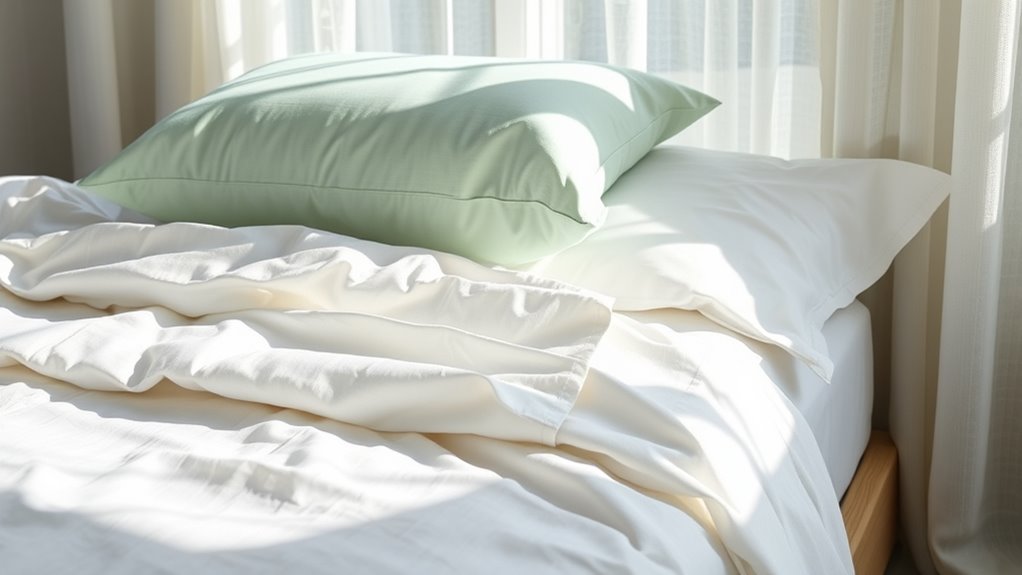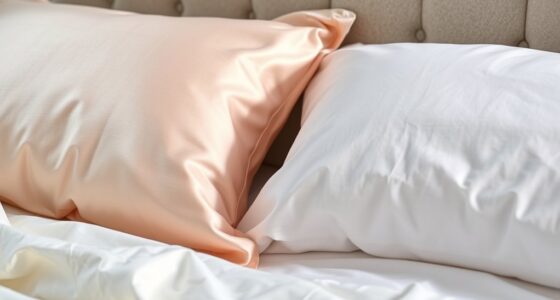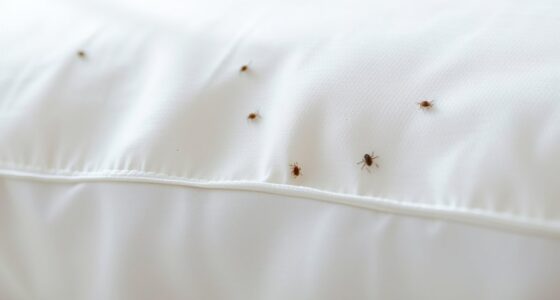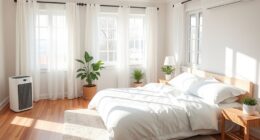To choose the right bedding for hot sleepers, opt for natural, breathable fabrics like cotton, linen, or bamboo that promote airflow and wick moisture away from your skin. Prioritize materials with loose weaves and lower thread counts to enhance ventilation and prevent heat from trapping. Pair your bedding with a cool, well-ventilated room, using fans or AC if needed. Keep exploring to discover tips for creating the perfect sleep environment and staying comfortable all night.
Key Takeaways
- Opt for natural, breathable fabrics like cotton, linen, or bamboo to enhance airflow and moisture evaporation.
- Choose lightweight bedding with looser weaves such as percale or linen to improve ventilation.
- Select sheets with moisture-wicking properties to keep skin dry and regulate body temperature.
- Avoid heavy or tight-weave bedding that traps heat and restricts airflow.
- Combine breathable bedding with a cool, well-ventilated sleep environment for optimal comfort.
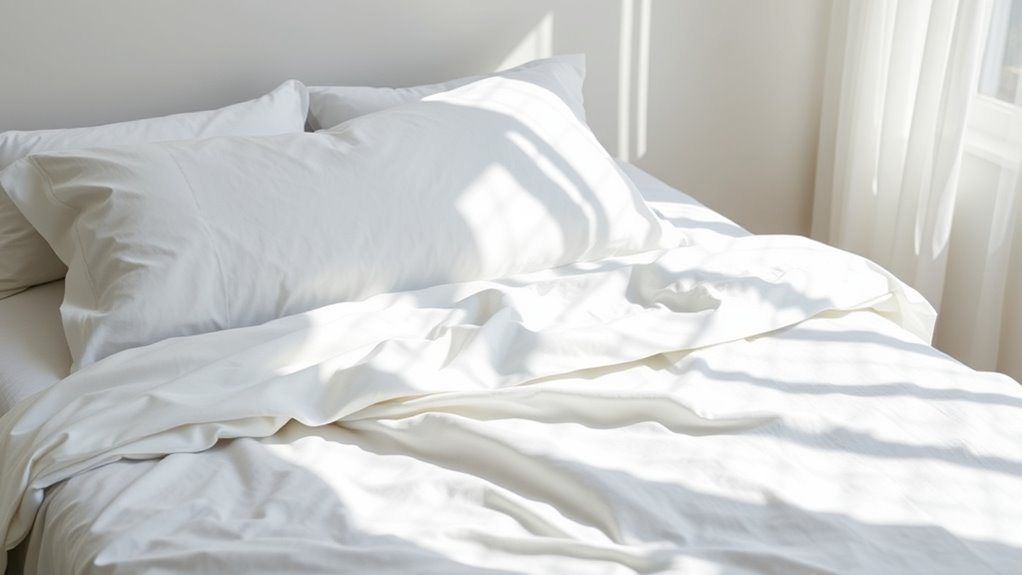
When you tend to sleep hot, selecting the right bedding can make all the difference in getting a restful night. The key lies in understanding how material breathability and sleep temperature regulation work together to keep you cool. Breathable fabrics allow air to circulate, helping heat and moisture escape from your body. This means your body stays cooler and drier throughout the night, reducing those uncomfortable waking moments caused by overheating. Materials like cotton, linen, and bamboo are popular choices because of their excellent breathability. They let heat dissipate and prevent heat from trapping against your skin, unlike synthetic fabrics that tend to trap heat and moisture.
Choosing bedding with good material breathability isn’t just about comfort — it’s about actively managing your sleep temperature. When your bedding promotes airflow, it helps regulate your body temperature, preventing the spikes that often wake hot sleepers. For example, lightweight, natural fabrics enhance ventilation, making it easier for your body to shed excess heat. This is especially important if you tend to toss and turn, as the right material can help you maintain a more consistent, comfortable temperature throughout the night. Additionally, look for bedding that has moisture-wicking properties. These fabrics pull sweat away from your skin, keeping you dry and further aiding in temperature regulation.
Another critical factor is the weave and thread count of your bedding. Looser weaves, like percale or linen, promote better airflow compared to tighter weaves, which tend to trap heat. A lower thread count can also improve breathability, but be sure it still feels comfortable against your skin. When selecting sheets and comforters, aim for those designed specifically for hot sleepers, often labeled as breathable or cooling. These are made to optimize ventilation and help you stay cooler for longer stretches of sleep.
Keep in mind that your bedding choice should be complemented by your overall sleep environment. Ensuring your room is cool and well-ventilated enhances the benefits of breathable bedding. Using fans or air conditioning can work in tandem with your bedding to help maintain a steady, comfortable sleep temperature. Ultimately, by prioritizing material breathability and sleep temperature regulation, you set the stage for a more restful, uninterrupted sleep. It’s about creating a sleep environment that works with your body, not against it, so you wake up feeling refreshed and ready for the day.
Frequently Asked Questions
Can I Use Cooling Pillows With Breathable Bedding?
Yes, you can definitely use cooling pillows with breathable fabrics. Cooling technology in pillows helps regulate your temperature, while breathable fabrics in bedding promote airflow and wick away heat. Combining these options creates a cooler sleep environment, preventing overheating. Make sure your pillow and bedding are compatible and designed for hot sleepers, so you can enjoy a comfortable, restful night without feeling too hot or sweaty.
Are There Specific Sleep Positions That Benefit From Certain Bedding?
Think of your sleep posture as a map guiding your bedding choices. If you sleep on your side, you might prefer softer, pressure-relieving bedding to cushion your shoulders. Back sleepers often need firmer support to keep your spine aligned. Knowing your sleep posture helps you choose bedding that supports comfort and temperature regulation, ensuring your sleep environment adapts to your preferences and promotes restful, cool sleep every night.
How Often Should I Replace My Hot Sleeper Bedding?
You should replace your bedding based on its bedding lifespan and replacement frequency recommendations. Typically, sheets and pillowcases last about 1-2 years, while pillows may need replacement every 1-2 years to maintain comfort and hygiene. If you notice signs of wear, stains, or loss of softness, it’s time to upgrade. Regularly changing your bedding helps you stay cool and comfortable, especially as a hot sleeper.
Is It Safe to Use Cooling Gels in Sheets?
Imagine your sheets as a shield, protecting you through the night. Cooling gels in bedding can be safe if they’re made with high-quality, non-toxic materials. They work like a gentle breeze, helping you stay cool. However, always check bedding safety labels and avoid gels with harmful chemicals. When properly manufactured, cooling gels can enhance comfort without risking your health, making your sleep both cool and safe.
Can Bedding Materials Cause Allergic Reactions in Hot Sleepers?
Bedding materials can indeed cause allergic reactions if you’re prone to allergies. Allergy triggers like dust mites, mold, or certain fabrics may lead to bedding sensitivities, especially when combined with heat and sweat. To avoid issues, opt for hypoallergenic sheets made from natural fibers like cotton or bamboo. Regular washing also helps reduce allergens, ensuring a cooler, more comfortable sleep without irritating your skin or respiratory system.
Conclusion
Don’t let hot nights keep you from restful sleep. While some might think lightweight bedding isn’t cozy enough, there’s a perfect balance between breathability and comfort for everyone. By choosing the right materials, like breathable cotton or cooling gels, you can stay cool without sacrificing comfort. So, give these options a try—you’ll be surprised how much better your sleep can be when you stay cool all night long.
